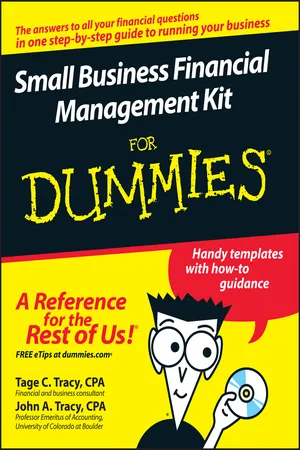
Small Business Financial Management Kit For Dummies
- English
- ePUB (mobile friendly)
- Available on iOS & Android
Small Business Financial Management Kit For Dummies
About this book
Small Business Financial Management Kit For Dummies explains step by step how to handle all your financial affairs, from preparing financial statements and managing cash flow to streamlining the accounting process, requesting bank loans, increasing profits, and much more. The bonus CD-ROM features handy reproducible forms, checklists, and templates—from a monthly expense summary to a cash flow statement—and provides how-to guidance that removes the guesswork in using each tool. You'll discover how to:
- Plan a budget and forecast
- Streamline the accounting process
- Improve your profit and cash flow
- Make better decisions with a profit model
- Raise capital and request loans
- Invest company money wisely
- Keep your business solvent
- Choose your legal entity for income tax
- Avoid common management pitfalls
- Put a market value on your business
Complete with ten rules for small business survival and a financial glossary, Small Business Financial Management Kit For Dummies is the fun and easy way® to get your finances in order, perk up your profits, and thrive long term!
Note: CD-ROM/DVD and other supplementary materials are not included as part of eBook file.
Frequently asked questions
- Essential is ideal for learners and professionals who enjoy exploring a wide range of subjects. Access the Essential Library with 800,000+ trusted titles and best-sellers across business, personal growth, and the humanities. Includes unlimited reading time and Standard Read Aloud voice.
- Complete: Perfect for advanced learners and researchers needing full, unrestricted access. Unlock 1.4M+ books across hundreds of subjects, including academic and specialized titles. The Complete Plan also includes advanced features like Premium Read Aloud and Research Assistant.
Please note we cannot support devices running on iOS 13 and Android 7 or earlier. Learn more about using the app.
Information
Part I
Improving Your Profit, Cash Flow, and Solvency

Chapter 1
Managing Your Small Business Finances
In This Chapter




Identifying Financial Management Functions








Tuning In to the Communication Styles of Financial Statements
-plgo-compressed.webp)

| Sales revenue | $5,218,000 | |
| Cost of goods sold expense | $3,267,000 | |
| Gross margin | $1,951,000 | |
| Sales and marketing expenses | $397,000 | |
| Administrative and general expenses | $1,087,000 | $1,484,000 |
| Operating profit | $467,000 | |
| Interest expense | $186,000 | |
| Net Income | $281,000 |



Table of contents
- Title
- Contents
- Introduction
- Part I : Improving Your Profit, Cash Flow, and Solvency
- Part II : Using Tools of the Trade
- Part III : Dealing with Small Business Financial Issues
- Part IV : Looking at Service and Manufacturing Businesses
- Part V : Reaching the End of the Line
- Part VI : The Part of Tens
- : Further Reading